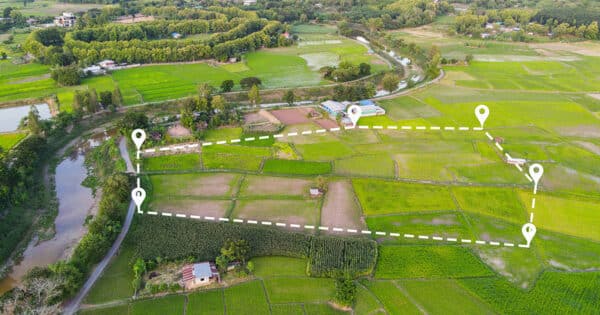It is estimated that 72% of land in the UK is farmed but, in 2017, the AGFORWARD project estimated that only 3% of that farmed area practised agroforestry. Whilst that project was focused on commercial forestry, agroforestry also includes boundary hedgerows, parkland, contour planting and woodland pasture. In other words, it is all those trees you see in a traditional English rural scene.
Such landscapes offer more than scenic appreciation and trees are more than mere ornaments on the landscape. An integration of trees and shrubs into the agricultural system brings a number of benefits to the farming business including contributing to climate change mitigation, increasing wildlife, improving soil health, ensuring good livestock welfare and management of water flow.
It is the recognition of these benefits which has largely driven a traditionally benevolent tax regime for woodlands over the last thirty years. For the lawyer, whether your client’s wooded areas on a farm or landed estate are shelter belts, forms part of a shoot, is operated to extract timber commercially, is used for paintballing, glamping or other leisure pursuits, it is important to consider the inheritance tax (IHT) implications on succession planning and the capital gains tax (CGT) implications of selling the timber or the land.
Selling the timber
The profitable gains from the sale of trees, standing or felled, including underwood from woodland managed on a commercial basis is exempt from CGT (s250 Taxation of Chargeable Gains Act, 1992 (TCGA)). This exemption also extends to insurance receipts in respect of damage or destruction of trees. The key here is that the woodland has to be managed on a commercial basis and therefore constitute a business which is being run with a view to profit.
That requires evidence and you would expect to see perhaps separate woodland accounts and definitely business and management plans. It takes a long time for trees to mature and it is not always realistic to demonstrate a profit particularly in periods of regeneration and replanting. In these instances HMRC are looking for viable long term intentions. There is therefore a need to have evidence of regular budget reviews and forecasts.
Other evidence which can help substantiate a claim that the woodland is run on a commercial basis includes employment contracts and worksheets (if the woodland is inhand) or invoices and details of work (if contractors are used), marketing activity such as customer contracts and website, evidence of the frequency of transactions and details of any supplemental work and sales such as the storing and seasoning of wood for the following year’s market.
Selling the underlying land
However, profit on the sale of the underlying land itself remains taxable. The sale and purchase price needs to be apportioned between the land and the value of the standing trees, timber and underwood on a just and reasonable basis.
Rollover Relief for CGT purposes is available for commercial woodlands (s152 TCGA, 1992) where they are managed by the occupier with a view to profit. However where land and standing trees are sold and rollover is claimed, in the UK the rollover relief is limited to the value of the land (excluding the value of standing trees). This makes sense because the standing trees themselves are exempt under s250 TCGA, 1992. Where the land is situated outside the UK, rollover relief will apply to the value of the land with the standing trees.
Holdover Relief also applies to the commercial occupation of woodlands (s165 TCGA, 1992) and is extended to woodland which is ancillary to the agricultural land or pasture (see below) and so qualifying for Agricultural Property Relief (APR).
For Business Asset Disposal Relief (previously Entrepreneur’s Relief) in order to qualify it must be trade as applies for the purposes of the Income Tax Act. The commercial occupation of woodland is not a trade for Income Tax purposes (s 11 Income Tax (Trading and Other Income) Act, 2005) and so the relief cannot apply to the sale of that land. However, detail is key. If the woodland being sold forms part of a larger trading farming estate (i.e perhaps the wooded areas constitute shelter belts) then the entire area will qualify for relief in full as there is no apportionment provision within the legislation for part use. HMRC will look carefully as to whether the overarching business is in fact commercial and so the requirement of evidence (accounts, receipts and business plans) remains.
Amenity woodland, short rotation coppice and Christmas trees
A lot of woodland found on farms is likely to fall under the category of amenity in that it is not being run commercially as a business itself with a view to making a profit. This is probably largely due to the fact that its primary existence is not to grow, process and remove timber for selling and more to do with improving soil health, ensuring good livestock welfare, stock proofing and management of water flow on the farmland. Consequently they are not covered by the exemption for commercial woodlands and as such any disposal of the felled trees are within the normal charge of CGT.
Short rotation coppice is not within the scope of the exemption as it is treated as farming. Coppicing is defined as a perennial crop of tree species planted at high density and which is harvested at least once every ten years. Willow and Poplar being common examples of species subjected to coppicing. The stems can be used as an energy crop as well as for fencing.
Nowadays, most Christmas tree production is from specialist Christmas tree producers or from farmers who grow the trees as a crop. As specialist growers, they are likely to be regarded as nurseries and so fall within the definition of market gardening rather then farming or commercial woodland.
Inheritance tax
Woodlands relief
Whilst this is called a relief it is really a deferral of tax. Under s125 of the Inheritance Tax Act, 1984 (IHTA), it is possible to claim relief on the value of any trees or underwood growing on the land.
The relief only generally applies when Agricultural Property Relief (APR) and Business Property Relief (BPR) cannot be achieved and only on transfers made on death. The claim must be made within two years of the date of death although HMRC do have discretion to accept later claims.
The election does two things:
- No IHT is payable on the timber until it is sold or given away or otherwise disposed of. A disposal of an interest in the timber is treated as a disposal of the timber itself; and
- If the disposal is a sale for full money’s worth, i.e. market value, tax is then chargeable on the net worth proceeds of sale. If not, tax is chargeable on the net value at the time of disposal. Selling expenses may be deducted as well as the expenses of replanting within three years of disposal.
The decision whether to elect or not lies in estimating the increase in value which will take place between the date of death and the time of ultimate sale. The greater the increase, the longer the period of time before the sale and these two factors may be regarded as self-cancelling. Where there is going to be a large increase in value, for example the trees are immature on death then and election may not be beneficial. Where the trees are relatively mature and there is a little appreciation of value then election may be more beneficial.
The matter can be decided on a land title basis so that each title is considered independently and therefore it is possible to elect for mature parts of an estate to apply for Woodlands Relief and the immature parts not. This can be helpful on larger estates where it is not possible to claim either APR (because the woodlands are not occupied with agricultural land and are ancillary to it) or BPR (because the woodlands are not managed on a commercial basis).
Business property relief
Woodlands on their own (see below for woodlands forming part of a larger estate) qualify for BPR provided the woodlands are run as a business on a commercial basis. The effect is that no IHT will be payable on the owner’s death on either the land or the trees. The key here, as with CGT, is that the business has to be on a commercial basis. Therefore documentary evidence to support the claim is vital.
As this is a separate commercial entity then separate woodland accounts should be available definitely for two years and preferably for a lot longer. There should be business reasons to explain periods when the business did not make a profit, such as times of re-planting, backed up with a comprehensive business plan, cropping and management schemes. Sale and expenditure receipts together with marketing material – copies of advertisements, website pages, planned marketing campaigns, customer registrations and marketing literature – are all helpful to build up the picture of a fully functioning business.
The reality, however, on a lot of farming and landed estate businesses is that the woodland is not part of a separate business but is part of a diversified activity within a larger farming business. This was, of course, the position in the Balfour case (Revenue and Customs Comrs v Brander (as Executor of the Will of the Late Fourth Earl of Balfour) (2010) UKUT 200 (TCC), (2010) STC 2666)). Here the assets in the business consisted both of non-business investment activities (lettings) and business investment activities.
As a traditional landed estate there was farming activities and to some extent forestry and woodland management and a shoot. The letting side of the activities were ancillary to the farming, forestry and woodland activities. Therefore BPR applied to the whole estate and so if the woodland is a business activity on which BPR is to be claimed, then the non-business investment activities might also accrue BPR as part of the whole business.
Agricultural property relief
Woodland is only agricultural property if it is occupied with, and ancillary to, agricultural land or pasture. This definition including woodland shelter belts, game coverts, fox coverts, coppices grown for fencing materials on the farm and clumps of amenity trees or spinneys.
The IHT manual (IHTM24030) states:
‘provided the woodland is occupied as part of the agricultural operation or even ancillary to the farming then it is appropriate to make a claim for APR. The woodland should be supplementary and/or supporting to the main activity of agriculture and it will be necessary to show evidence of this (such as maps, accounts and notes of how the woodland is used). Woodlands can benefit from APR where they are ancillary to farmland, such as shelter belts or where firewood and fencing are taken or where the activity of a short rotation coppice is carried out’.
The use of woodland can also be part of the agricultural activity in a large number of ways. For example, in the case of ‘fly tipping’ and intrusion of boundaries a farmer has used the woodland to make their farms more secure and the agricultural activity more productive through fencing and boundary protection. The key criteria is that where woodland is ancillary to agricultural land and pasture it can benefit from APR as it will qualify as agricultural property.
Again evidence is key. Any income and expenditure should be clearly shown in the farming accounts. These accounts should clearly reflect the exact nature of the business activity of any woodland, and that includes any barter transactions involving the woodland must be accurately recorded and reflect the two sided entries of the barter. For example, what the wood was swapped for.
A plan with contours of the farm clearly marking the fields and the wooded areas can assist in demonstrating that the woodland is ancillary to the farming activities. Photographs of livestock sheltering by a wooded area and workers extracting wood for firewood sales and fencing (preferably with a date stamp) are helpful. The more background evidence you are able to provide to HMRC the quicker and easier it should be for them to come to a decision on the availability of APR.
Consideration of the bigger strategic picture should be made before any claim for Woodland Relief, APR or BPR is made. If there is a greater need for APR on the farmhouse then one advantage of claiming APR on the woodland is the emphasis it affords on the agricultural activity on the land that surrounds the farmhouse. Alternatively, if there is a greater need for trading activity on the diversified estate then a claim for BPR may assist in improving the Balfour matrix and tipping the balance away from a preponderance of investment activities.
Land values over the last twenty years have risen significantly. In addition, the Agricultural Act 2020 provides the power to make payments for a range of public goods which will form part of a future environmental land management scheme. The ELMS regime may include restoring and enhancing natural eco systems via large scale tree planting and the creation of woodlands as well as focussing on other habitats such as wetlands, fens and bogs.
When this scheme is launched in 2024 the existence of agroforestry on the farm is likely to garner more importance. It is therefore going to be even more critical to seek specialist valuation advice on those wooded areas and to consider carefully the evidence and availability of tax relief for our clients.
How Moore Barlow can help
If you require advice on the tax implications of woodland, contact our expert team today.







